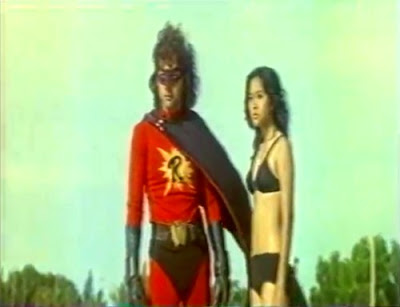The Golden Claws of the Cat Girl’s title gives it a lot to live up to, as does its superficial resemblance to
Danger: Diabolik, which is perhaps the Platonic ideal of fun 1960s pop art Eurocrime films. Some who come to it with expectations based on that resemblance may be disappointed, as there are more differences between the two than similarities.
One of the key differences is that, while
Diabolik is based on a comic book,
Cat Girl is based on, well, a
book book, in particular
La Louve Solitaire (“The Lone Wolf”) by French crime novelist Albert Sainte-Aube. This was the first of a series of 12 novels that featured as their protagonist glamorous circus-acrobat-turned-cat-burglar Françoise Dilmont, which were written by Saint-Aube between 1967 and 1973. Indeed,
Cat Girl first came into this world bearing the title
La Louve Solitaire. That is, until someone—I suspect the Italians—decided to sex it up.
Our introduction to Françoise, aka “The She Wolf”, comes in the film’s opening scene. Looking every bit like a lady version of Diabolik in her black head-to-toe body stocking, she stages a perilous burglary that involves walking a tightrope strung high above a courtyard filled with frugging partygoers, then, ill-gotten gains in hand, making her getaway in a gleaming red Firebird. Later we learn that she is a high end real estate dealer by day, and uses her knowledge of the homes she sells her clients to rob them blind once they move in. Personally, I find this to be an implausible set-up, mainly because I live in San Francisco, where realtors tend to take all of your money up front.
The She Wolf’s next caper turns out to be a sting mounted by Durieux (Julien Guiomar, of Costa-Garvas’
Z), an official with the French secret police. Somewhat predictably, Durieux has a job to which Françoise’s talents are uniquely suited and, in return for her taking it on, will grant her freedom—with the caveat that, upon completion, she leaves the country immediately and never returns. The target of this job is a diplomat from “one of the new independent republics” who is using his diplomatic immunity to act as a drug courier for a mysterious Mr. Big named Saratoga, who, in another example of
Cat Girl’s toney casting, is played by
Last Year at Marienbad’s Sacha Pitoëff. Françoise’s assigned task will be to steal the diplomat’s latest package, containing 20 kilos of synthetic heroin, presumably with the intent of getting him into hot water with his boss.
Françoise is portrayed by Daniele Gaubert, a French actress who was undergoing something of a career renaissance at the time, having recently returned to the screen after a long absence. This absence was occasioned by her marriage, in 1963, to the son of Dominican dictator Rafael Trujillo, a marriage that was coming to a messy conclusion by the time of
Cat Girl’s release. That her public’s hearts had grown founder of her during this period is evidenced by her sudden elevation, upon her return, from supporting to lead roles. It was during the years surrounding
Cat Girl that she would star in some of her most well remembered films, including
Paris N’existe Pas with Serge Gainsbourg and Radley Metzger’s
Camille 2000. Four years later, in 1972, she starred in the caper film
Snow Job, on which she met her second husband, skier Jean-Claude Killy, who would remain with her until her death from cancer in 1987.
To her portrayal of Françoise, Gaubert brings little of the cocky
joie de vivre that we tend to prefer in our altruistic bandits and, as a sex symbol, comes off as more sullen than sultry. This may have been the point, of course. After all, Francoise is performing her daring do under duress from The Man here, and has every right to be po-faced about it. There is also the matter of her being portrayed from the start as something of an ice princess who cares only for money, which sets the stage nicely for the moment when she starts to find her heart being melted by her leading man. In any case, this puts the onus upon the elements surrounding Gaubert to give
Cat Girl its pop. Among these are playful mod-era touches like Francoise’s tricked-out subterranean bachelorette pad (another nod to
Diabolik) and a couple of scenes of hipsters go-go dancing to twangy pop music. There is also Francis Lai’s sleek Euro-jazzy score and, lest we forget, the game performances of Gaubert’s supporting players.
Among these is Claude Chabrol favorite Michel Duchaussoy (
This Man Must Die), who plays Bruno, an agent with a gift for lip reading who is assigned to be Françoise’s partner in her mission. This mission essentially involves Françoise and Bruno being parked in a hotel room across from their suspect’s embassy. Here they exchange flirty non sequiturs while spying on the diplomat’s office, waiting for him to receive the shipment of heroin. Finally, in a very
Rear Window inspired scene, Francoise, after accessing the embassy’s upper floors by trapeze, rifles through the diplomat’s office as Bruno watches anxiously through a telescope.
Much like in
Rear Window, the diplomat makes an unexpectedly early return and tries to shoot Françoise, only to be taken down by a sniper’s bullet from Bruno. Her job now done, Francoise hightails it to Geneva, only to find herself being pursued by two of Saratoga’s psychotic henchmen, Silvio and Hans—the last named played by Jacques Brunet in what would be, were this a German Eurospy film, the Horst Frank role.
The Golden Claws of the Cat Girl was one of only two theatrical features directed by Edouard Logereau, who worked extensively in European television. Logereau brings an assured hand to the task, but what he should really be credited for is being so keenly aware of the tradition within which he was working. Not only am I referring here to the aforementioned Hitchcock riff and the familial nods to
Danger: Diabolik, but also to the repeated scenes of Françoise Gaubert, clad in a black cat suit, scampering across the rooftops of Paris. These are an unmistakable homage to Louis Feuillade’s classic serial
Les Vampires, in which actress Musidora traversed those rooftops in much the same fashion--scenes that were payed similar homage by Olivier Assayas in his 1996 film
Irma Vep.
Another thing that is striking about
Cat Girl, Alongside Logereau’s genre savvy, is just how violent it is
not. The shooting of the diplomat aside, there are no onscreen deaths until the film’s last few minutes, and those are not dwelt upon. The film also lacks the rote action set pieces—car chases, fist fights—that dot the typical Euro-thrillers of its era. In place of them are the scenes depicting Francoise’s burglaries, which are all accomplished with live stunt work, rather than the rear projection of cheesy process shots you might expect. In other words, they look refreshingly real, and as such can be forgiven those odd moments when the camera fails to hide the masculine proportions of Francoise Gaubert’s stunt double.
In the final tally,
The Golden Claws of the Cat Girl’s cosmetic resemblance to
Danger: Diabolik does not serve it well, as it lacks that film’s giddy irreverence and excitement. It is nonetheless a very enjoyable film in its own right, marked by solid performances from an accomplished cast, a glamorous setting, and a screenplay with a fair share of unexpected twists. In my case, it also appeals due to the fact that I am currently house shopping. It amuses me to think that one of these skinny, nervous women who insist upon showing me houses I can’t afford might be a thrill-seeking cat burglar in disguise.












































































































